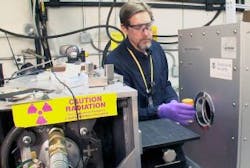MRI and X-ray imaging technologies combined for enhanced airport security imaging
Scientists from Los Alamos National Laboratory have developed a new imaging technique which combines magnetic resonance imaging (MRI) technology with low-power x-ray data to enable more robust detection capabilities.
The project, which is funded in part by the Department of Homeland Security’s Science and Technology Directorate, is being called MagRay. MagRay engineer Larry Schultz explains that there are a certain set of liquids, including homemade explosives and other compound mixes where a nuclear magnetic resonance (NMR) signature to indicate with high confidence whether a material is a threat or is benign. As a result, the team looked to develop a scientific imaging system that could more accurately detect liquid threats.
With the support of DHS, the team brought MRI technology together with x-ray imaging, which according to Michelle Espy, MagRay team leader, creates a sum that is greater than the constituent parts put together due to the new information that is made available. The team looked at where a particular liquid fell in a three-dimensional graph of NMR proton content. By plotting these points, the team was able to identify a potential threat versus a benign liquid.
"We're looking for where a liquid lies in a sort of three-dimensional space of MRI, proton content, and X-ray density,” said Schult. "With those measures we find that benign liquids and threat liquids separate real nicely in this space, so we can detect them quickly with a very high level of confidence."
The ultimate objective of the project was to develop and commercialize a system that, without any intervention from an operator, would determine whether or not a particular liquid was a threat or not. Quite obviously, such a technology would stand to improve existing capabilities at airports.
View the press release.
Also check out:
NIST video imaging prototype detects hidden weapons and threats
Vision system acts as electronic police for traffic violations in China
Researchers create remote traffic pollution detection camera prototype
Share your vision-related news by contacting James Carroll, Senior Web Editor, Vision Systems Design
To receive news like this in your inbox, click here.
Join our LinkedIn group | Like us on Facebook | Follow us on Twitter | Check us out on Google +
About the Author

James Carroll
Former VSD Editor James Carroll joined the team 2013. Carroll covered machine vision and imaging from numerous angles, including application stories, industry news, market updates, and new products. In addition to writing and editing articles, Carroll managed the Innovators Awards program and webcasts.
